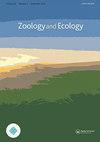Waterbirds in the panhandle of the Okavango Delta: dry season counts over two seven-year periods
Q4 Environmental Science
引用次数: 3
Abstract
We counted waterbirds along a fixed route in the panhandle of the Okavango River in Mahango Game Reserve in the dry season during two seven-year periods (1991–1997 and 2000–2006). Palearctic migrants represented by 11 species in 1991–1997 and nine species in 2000–2006 together composed only a small percentage of all birds recorded in both periods. The two most numerous foraging guilds were birds foraging in shallow water and those foraging in deep water. The former guild was more numerous in 2000–2006, while the latter guild was more numerous in 1991–1997. The proportion of other foraging guilds varied little between the two periods. The most numerous diet guild was piscivores, they were more numerous in 1991–1997 than in 2000–2006. If the total numbers of birds of each particular species in the years 1991–1997 were pooled and compared with those for the years 2000–2006, then highly significant changes in their numbers between these periods could be seen for 53 out of 93 waterbird species. Over the timespan 1991–2006, 12 species significantly increased in numbers while one species, the Cattle Egret, declined; seven other species showed no significant changes in abundance. The increase can be linked to the volume of water flowing through the river. While during the years 1991–1997 the total volume measured at Mohembo was 45.9 km3 (SD = 1.43), during the years 2000–2006 the volume was 60.9 km3 (SD = 1.41). Diversity was very similar during the two periods (1991–1997: S = 1.4; 2000–2006: S = 1.3), with no difference in evenness. The striking feature is that species diversity and abundance of birds was far greater than any records from other southern African rivers to date.奥卡万戈三角洲狭长地带的水鸟:旱季超过两个七年
在两个七年的旱季(1991-1997年和2000-2006年),我们在马汉戈禁猎区奥卡万戈河狭长地带的一条固定路线上对水鸟进行了计数。1991-1997年有11个物种和2000-2006年有9个物种代表的北北极候鸟在这两个时期记录的所有鸟类中只占很小的比例。数量最多的两个觅食群体是在浅水中觅食的鸟类和在深水中觅食的鸟。前一个公会在2000-2006年数量更多,而后一个公会则在1991-1997年数量更多。在这两个时期,其他觅食团体的比例变化不大。数量最多的饮食协会是杂食动物,它们在1991-1997年的数量比2000-2006年的数量还要多。如果将1991-1997年每个特定物种的鸟类总数与2000-2006年的鸟类总数进行汇总并进行比较,那么93种水鸟中的53种在这两个时期的数量可能会发生非常显著的变化。在1991-2006年期间,12个物种的数量显著增加,而一个物种,牛白鹭,数量减少;其他7个物种的丰度没有显著变化。这一增长可能与流经河流的水量有关。在1991-1997年期间,Mohenbo测得的总体积为45.9 km3(SD=1.43),而在2000-2006年期间,体积为60.9 km3。两个时期的多样性非常相似(1991-1997:S=1.4;2000-2006:S=1.3),均匀度没有差异。引人注目的特征是,迄今为止,鸟类的物种多样性和丰度远远超过南部非洲其他河流的任何记录。
本文章由计算机程序翻译,如有差异,请以英文原文为准。
求助全文
约1分钟内获得全文
求助全文
来源期刊

Zoology and Ecology
Agricultural and Biological Sciences-Animal Science and Zoology
CiteScore
1.00
自引率
0.00%
发文量
1
 求助内容:
求助内容: 应助结果提醒方式:
应助结果提醒方式:


